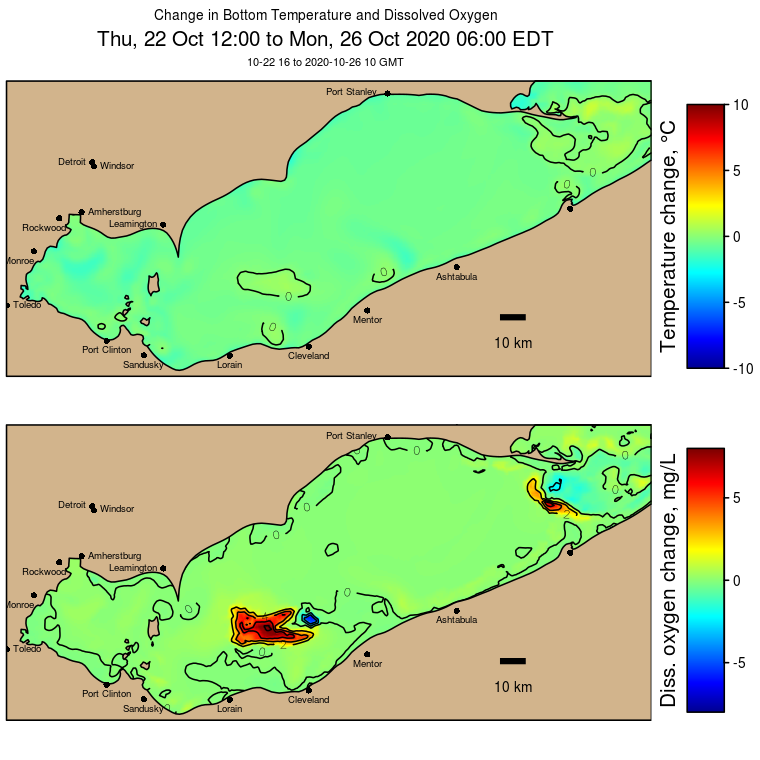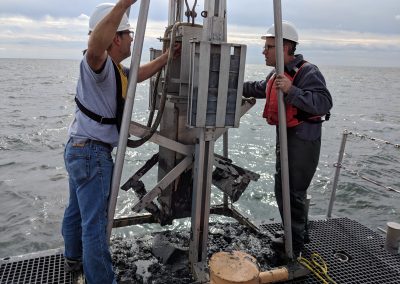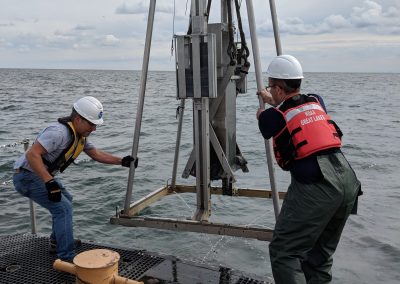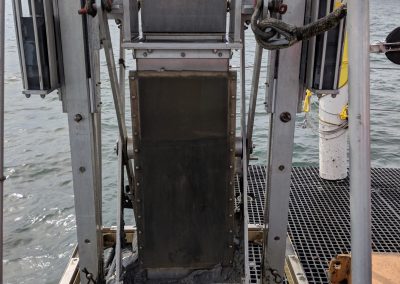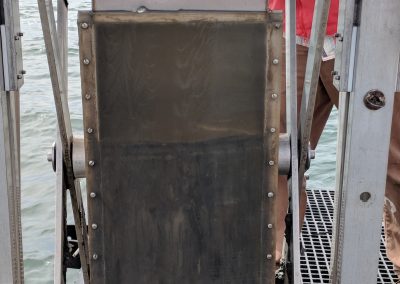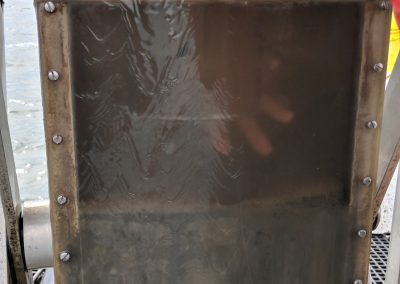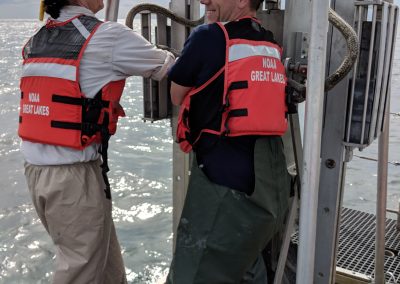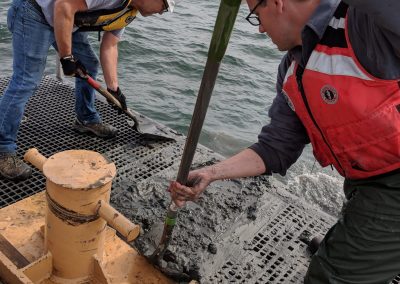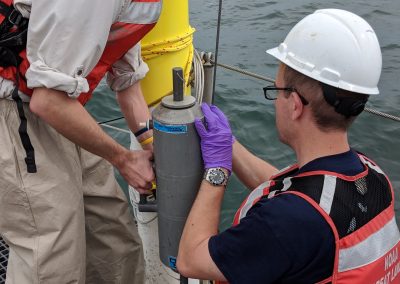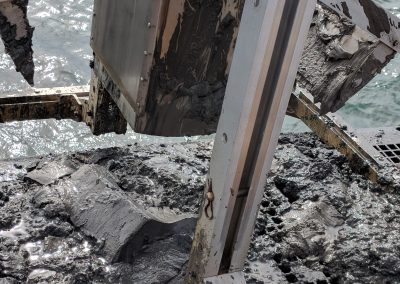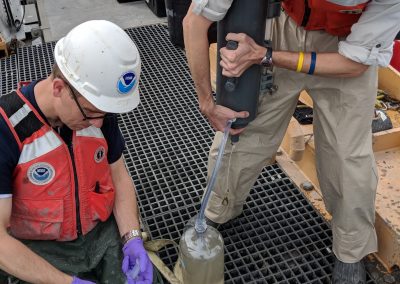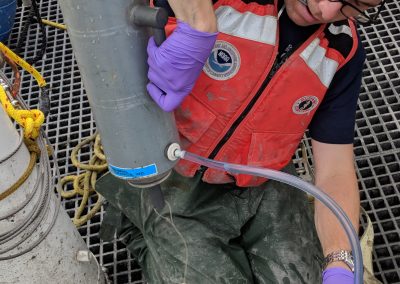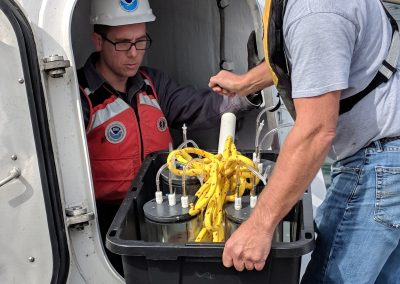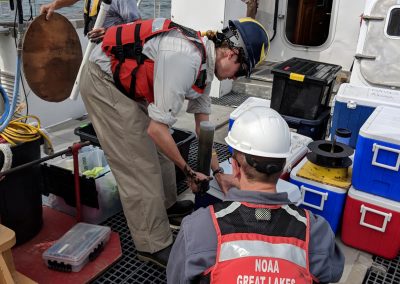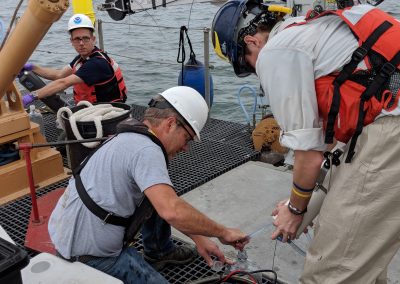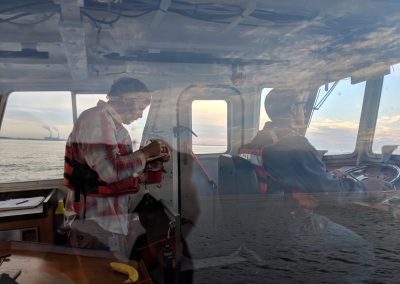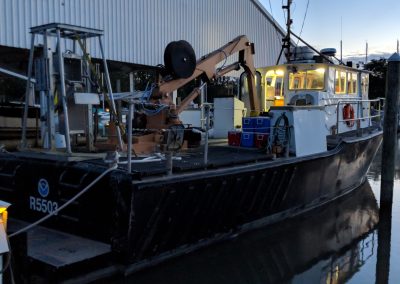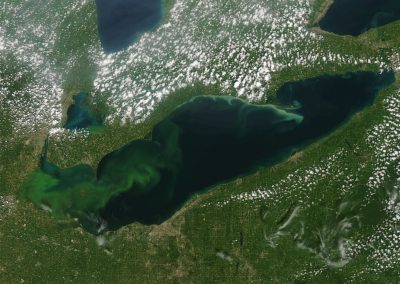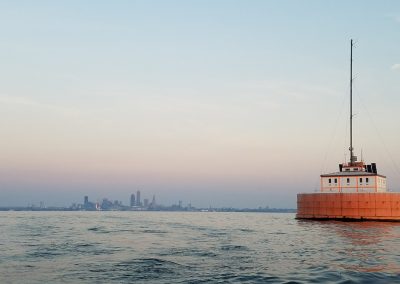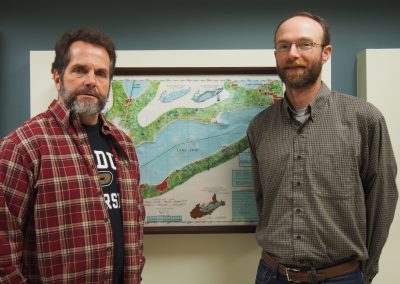Hypoxia Early Warning System
Lake Erie’s “dead zone” impacts the lake’s ecosystem and poses challenges for managers of drinking water treatment facilities.
Episodes of low dissolved oxygen, or hypoxia, are common during the summer in the bottom water of the central basin of Lake Erie, a source of drinking water for millions of people in northwest Ohio. The hypoxic area or “dead zone” in Lake Erie can grow as large as 6,000 square miles, or 63% of the lake surface area.
With our partners at NOAA GLERL, CIGLR is at the forefront of monitoring and forecasting hypoxia in the Great Lakes, for the protection of human and ecosystem health. Our hypoxia research activities include:
Coastal Hypoxia Research Program (CHRP)
Hypoxic water is usually discolored, acidic, and may contain iron and manganese, requiring costly treatment to avoid undesirable taste and aesthetic problems when it enters drinking water intakes.
In Lake Erie, it is common for strong gradients in water quality to exist between surface water and bottom water in the summer, when the water column is stratified. Because hypoxia events are typically triggered by changes in weather and hydrodynamics (i.e., lake temperature and circulation), they can occur quickly and leave water intakes to be alternately exposed to surface or bottom water and leave drinking water managers little time to prepare for changes in treatment. Surface water has higher pH, and may have high concentrations of phytoplankton, dissolved organic matter, and potentially algal toxins. In contrast, bottom water may have low pH and low dissolved oxygen. This low-oxygen water may contain iron and manganese, which requires additional treatment to remove.
A research team led by scientists from CIGLR and NOAA GLERL is developing a forecasting system to predict the location and movement of hypoxic water in Lake Erie. This system will give advanced warning when conditions are likely to promote hypoxic water movement into the vicinity of drinking water intakes, providing drinking water managers time to prepare for changes in water quality and implement appropriate treatment processes. The forecast system will be supported by in-lake monitoring sensors to measure oxygen concentrations and give an unprecedented view of the complex lake dynamics that control the development and movement of hypoxic lake bottom water.
About the Project
This 5-year project is in collaboration with the City of Cleveland Division of Water, Purdue University, and U. S. Geological Survey, with guidance from a management advisory group including representatives from Ohio public water systems, Ohio EPA, Great Lakes Observing System (GLOS), and NOAA. The work is supported by a $1.4 million award from the NOAA National Centers for Coastal and Ocean Science (NCCOS) Coastal Hypoxia Research Program (CHRP).
2019 Lake Erie CSMI
Monitoring and experimental activities were expanded to further advance the development of the hypoxia model and to better predict when hypoxic water will pose a threat to drinking water intakes. One of the most pressing needs for water intake managers is to better understand the factors controlling the distribution of the naturally-occurring metal manganese (Mn), which is released from sediments in Lake Erie during hypoxia and can accumulate in the water. Results from these experiments have improved our understanding of how hypoxia impacts the accumulation of the heavy metal Mn and the limiting nutrient phosphorus (P). Our experiments and instrument deployments gave remarkably similar estimates of the lag time between the onset of anoxia (water depleted of dissolved oxygen, a more severe condition of hypoxia) and release of P. The high-resolution dissolved oxygen data from the Coastal Hypoxia Research Program project show that the onset of anoxia in the central basin is highly variable among stations and years. Combined with the new information on P release, the research team will show that previous estimates of internal loading of P to Lake Erie are highly uncertain and likely overestimate the total flux by up to 50%. Separately, our findings on Mn dynamics fill a major gap in hypoxia research in Lake Erie. Mn-laden hypoxic water is a major challenge for water treatment facilities and our results could be used to inform new ways to predict when and where those treatment facilities are likely to experience high Mn conditions.
Incorporating Human Dimensions
To meet the needs of coastal communities, public health officials, and local water quality managers and decision-makers, the research team includes social scientists that are addressing the human dimensions of hypoxia forecasting in the Great Lakes. This team is co-designing an experimental hypoxia forecast with public water system professionals to better understand how hypoxia affects public water systems, and to develop a product that meets their information needs as they seek to ensure the delivery of high quality drinking water.
Learn more about our hypoxia focused stakeholder workshops and events by following this link.
Stay up-to-date on the most recent news and scientific media generated from our Hypoxia Research here:
Products & Resources
- Lake Erie Hypoxia Forecast (website)
- NOAA GLERL HABs and Hypoxia main page (website)
- Harmful Algal Blooms (HABs) & Hypoxia (CIGLR factsheet)
- The Story of Hypoxia (NOAA GLERL infographic)
- Hypoxia Research (bookmark)
News
- U of M team makes discovery about Lake Erie dead zone, Great Lakes Now, 3/11/2021
- New study tackles Lake Erie’s “dead zone”, NOAA Research, 3/1/2021
- U of M team makes discovery about Lake Erie dead zone, Michigan Radio, 3/1/2021
- Release of nutrients worsens Lake Erie’s annual ‘dead zone’, The University Record, 2/22/2021
- New Study Provides Better Understanding of Lake Erie ‘Dead Zone’, WEMU 89.1, 2/22/2021
- The release of nutrients from lake bottom sediments exacerbates Lake Erie’s annual “dead zone”, Michigan News, 2/19/2021
- Release of nutrients from lake-bottom sediments worsens Lake Erie’s annual ‘dead zone’, Science Daily, 2/19/2021
- The release of nutrients from sediments on the lake floor worsens the annual “dead zone” of Lake Erie and could intensify as the climate warms up, newsbeezer.com, 2/19/2021
- Release of nutrients from lake-bottom sediments worsens Lake Erie’s annual ‘dead zone’, Science Bulletin, 2/19/2021
- Lake Erie dead zone threatens Cleveland drinking water, Cleveland.com Metro News, 7/26/2018
- Forecasting ‘Dead Zones’ to Help Protect Drinking Water; Great Lakes Connection, 8/4/2017
- Update on Lake Erie hypoxia forecasting stakeholder workshop; NOAA GLERL Blog, 06/28/2017
- Lake Erie Hypoxia Forecasting Project Kicks Off With Stakeholder Workshop; NOAA GLERL Blog, 03/24/2017
- U.S. Scientists Working to Predict Lake Erie Hypoxic Water; Water Canada, 12/9/2016
- Researchers creating warning system for low oxygen water; Great Lakes Echo, 12/9/2016
- NOAA, partners predict smaller harmful algal bloom for western Lake Erie; NOAA News and Features, 7/7/2016
- After ‘Green Slime’ Algal Bloom, Drought Now Causes Massive Dead Zone in Lake Erie; Tech Times, 1/8/2015
- Lake Erie is Suffering From its Largest Dead Zone in Decades; Nature World News, 1/7/2015
- Drought led to massive ‘dead zone’ in Lake Erie; ScienceDaily, 1/6/2015
- Drought led to massive ‘dead zone’ in Lake Erie; phys.org, 1/6/2015
- UM Study: Tough New Pollution Targets Needed To Shrink Lake Erie Dead Zone; CBS Detroit, 2/26/2014
- Ambitious New Pollution Targets Needed to Protect Lake Erie From Massive ‘Dead Zone’; NewsWise, 2/26/2014
Publications
Anderson, H.S., T.H. Johengen, C.M. Godwin, H.Purcell, P.J. Alsip, S.A. Ruberg and L.A. Mason. 2021. Continuous In Situ Nutrient Analyzers Pinpoint the Onset and Rate of Internal P Loading under Anoxia in Lake Erie’s Central Basin. Environmental, Science, and Technology: Water. (DOI:10.1021/acsestwater.0c00138). [Altmetric Score]
Biddanda, B.A., A.D. Weinke, S.T. Kendall, L.C. Gereaux, T.M. Holcomb, M.J. Snider, D.K. Dila, S.A. Long, C. VandenBerg, K. Knapp, D.J. Koopmans, K. Thompson, J.H. Vail, M.E. Ogdahl, Q. Liu, T.H. Johengen, E.J. Anderson and S.A. Ruberg. 2017. Chronicles of hypoxia: Time-series buoy observations reveal annually recurring seasonal basin-wide hypoxia in Muskegon Lake – A Great Lakes estuary. Journal of Great Lakes Research. (DOI:10.1016/j.jglr.2017.12.008). [Altmetric Score]
Godwin, C.M.; J.R. Zehnpfennig and D.R. Learman. 2020. Biotic and abiotic mechanisms of manganese (II) oxidation in Lake Erie. Frontiers in Environmental Science. (DOI:10.3389/fenvs.2020.00057). [Altmetric Score]
Liu, Q., E.J. Anderson, Y. Zhang, A.D. Weinke, K.L. Knapp and B.A. Biddanda. 2018. Modeling reveals the role of coastal upwelling and hydrologic inputs on biologically distinct water exchanges in a Great Lakes estuary. Estuarine, Coastal and Shelf Science. (DOI: 10.1016/j.ecss.2018.05.014). [Altmetric Score]
Rowe, M.D., E.J. Anderson, D. Beletsky, C.A. Stow, S.D. Moegling, J.D. Chaffin, J.C. May, P.D. Collingsworth, A. Jabbari and J.D. Ackerman. 2019. Coastal Upwelling Influences Hypoxia Spatial Patterns and Nearshore Dynamics in Lake Erie. JGR Oceans. (DOI:10.1029/2019JC015192). [Altmetric Score]
Rowe, M.D., E.J. Anderson, H.A. Vanderploeg, S.A. Pothoven, A.K. Elgin, J. Wang and F. Yousef. 2017. Influence of invasive quagga mussels, phosphorus loads, and climate on spatial and temporal patterns of productivity in Lake Michigan: A biophysical modeling study. Limnology and Oceanography. (DOI:10.1002/lno.10595). [Altmetric Score]
Rucinski, D.K., J.V. DePinto, D. Scavia and D. Beletsky. 2014. Modeling Lake Erie’s hypoxia response to nutrient loads and physical variability. Journal of Great Lakes Research. 40(Supplement 3):151-161. (DOI:10.1016/j.jglr.2014.02.003).
Stone, J.P.; K.L. Pangle; S.A. Pothoven; H.A. Vanderploeg; S.B. Brandt; T.O. Hook; T.H. Johengen and S.A. Ludsin. 2020. Hypoxia’s impact on pelagic fish populations in Lake Erie: A tale of two planktivores. Canadian Journal of Fisheries and Aquatic Sciences. (DOI:10.1139/cjfas-2019-0265). [Altmetric Score]
Stow, C.A., Y. Cha, L.T. Johnson, R. Confesor and R.P. Richards. 2015. Long-term and seasonal trend decomposition of Maumee River nutrient inputs to western Lake Erie. Environmental Science & Technology. 49:3392-3400. (DOI:10.1021/es5062648). [Altmetric Score]
Weinke, A.D. and B.A. Biddanda. 2017. From Bacteria to Fish: Ecological Consequences of Seasonal Hypoxia in a Great Lakes Estuary. Ecosystems. (DOI:10.1007/s10021-017-0160-x). [Altmetric Score]
Zhang, H., L. Boegman, D. Scavia and D.A. Culver. 2016. Spatial distributions of external and internal phosphorus loads in Lake Erie and their impacts on phytoplankton. Journal of Great Lakes Research. 42(6):1212-1227. (DOI:10.1016/j.jglr.2016.09.005). [Altmetric Score]
Zhou, Y., A.M. Michalak, D. Beletsky, Y.R. Rao and R.P. Richards. 2015. Record-breaking Lake Erie hypoxia during 2012 drought. Environmental Science & Technology. 49(2):800-807. (DOI:10.1021/es503981n). [Altmetric Score]
PrincipaI Investigator(s):
Casey Godwin (CIGLR)
NOAA Technical Lead(s):
Craig Stow (NOAA-GLERL)
Mark Rowe (NOAA-GLERL)
Hypoxia Photo Gallery
As with all research, there’s always cleanup! Cleaning up the remaining sediment from the box corer. Pictured: Russ Miller (left), Dr. Casey Godwin (right). The researchers focus to collect sediment and water samples from Lake Erie in an effort to learn more about the lake’s oxygen levels, specifically its hypoxia events. Photo Credit: Aubrey Lashaway.
Dr. Godwin (pictured right) and Dr. Thomas Johengen along with colleagues Russ Miller (pictured left) and Dack Stuart collect Lake Erie sediment using a box corer (center) which is designed to bring back a nearly intact sample of the lake bottom.
Individual cores were taken from the box corer for processing back at NOAA GLERL. In the lab, our scientists study Lake Erie’s sediment chemistry and oxygen demand.
Lake Erie hypolimnion water-the bottom layer of water-was sampled using Niskin bottles. The Niskin bottle samples were emptied into plastic bottles, & some filtered, for transport back to the laboratory. Pictured: Dack Stuart (left), Dr. Casey Godwin (right).
Collecting Lake Erie water from a Niskin Bottle Sampler. Pictured: Dr. Casey Godwin. Photo Credit: Aubrey Lashaway.
Collecting a sub sample from the sediment core collected from Lake Erie. Pictured: Dack Stuart. Photo Credit: Aubrey Lashaway.
Preparing the Lake Erie sediment sampling materials. Pictured: Dr. Casey Godwin (left), Russ Miller (right). Photo Credit: Aubrey Lashaway.
Preparing the Lke Erie sediment sampling materials. Pictured: Boat Captain Daniel Burlingame (back), Russ Miller (middle left), Dack Stuart (middle right), Dr. Casey Godwin (front). Photo Credit: Aubrey Lashaway.
Preparing the Lke Erie sediment sampling materials. Pictured: Dr. Casey Godwin (left), Russ Miller (center), Dack Stuart (right). Photo Credit: Aubrey Lashaway.
Heading out to collect sediment from Pictured: Boat Captain Daniel Burlingame (left), Dr. Casey Godwin (right). Photo Credit: Aubrey Lashaway.
A portion of Dr. Godwin’s research at CIGLR & UM-SEAS involves collaboration with NOAA GLERL scientists to collect sediment and water samples from Lake Erie in an effort to learn more about the lake’s oxygen levels, specifically its hypoxia events. Photo Credit: Aubrey Lashaway.
MODIS satellite image of Lake Erie harmful algal bloom, August 2015. Photo Credit: NOAA Great Lakes CoastWatch.
Cleveland Skyline and Cleveland Water Intake Crib. Daily, about 165 million gallons of water leaves Lake Erie through the crib to the pump station, where the water will begin treatment before it flows to other water facilities. Photo Credit: Ed Verhamme.
Dr. Mark Rowe (GLERL), right) and Dr. Craig Stow (GLERL, left) team up to develop a forecasting system to predict the location and movement of hypoxic water in Lake Erie. Photo Credit: Michele Wensman.
Scientists and partners from LimnoTech, the NOAA Great Lakes Environmental Research Laboratory and CIGLR meet with chemists and managers at the Toledo Water Treatment Plant. We work together to improve data communication, and to support and prepare the City Of Toledo for the 2017 algal bloom season. Photo Credit: Devin Gill.
Video Library
Biogeochemistry Breakdown: The Story Of Hypoxia. Learn more about this phenomenon by watching CIGLR’s first animated, educational video about hypoxia.
Video Library
NOAA GLERL’s Dr. Mark Rowe looks at Lake Erie hypoxia from a different point of view as he presents at the Great Lakes Seminar Series.
Video Library
A Lake Erie upwelling event brought hypoxic water to drinking water intakes along the Ohio shoreline of Lake Erie on September 3, 2016. The animation shows a cross sectional view of Lake Erie from the shoreline near Cleveland to the location of the “Dead Zone” buoy 15 miles north of Cleveland for two weeks surrounding the upwelling. Temperature and dissolved oxygen from an experimental forecast model are shown on the color scale. The north-south component of currents in the lake are shown by the arrows.

